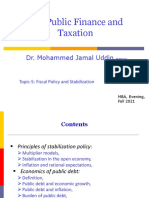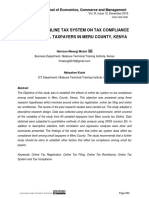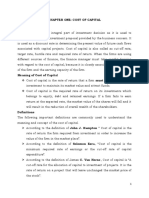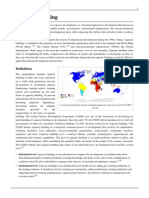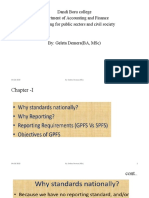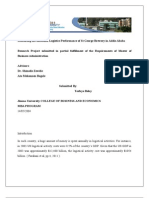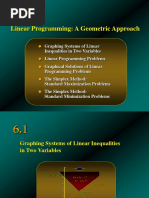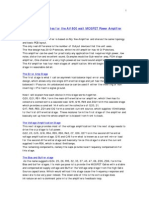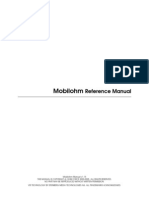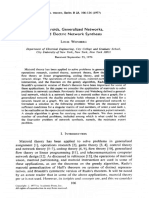A Study of The Factors That Determine Local NGO Financial Sustainability, A Case of CIDRZ
A Study of The Factors That Determine Local NGO Financial Sustainability, A Case of CIDRZ
Copyright:
Available Formats
A Study of The Factors That Determine Local NGO Financial Sustainability, A Case of CIDRZ
A Study of The Factors That Determine Local NGO Financial Sustainability, A Case of CIDRZ
Original Title
Copyright
Available Formats
Share this document
Did you find this document useful?
Is this content inappropriate?
Copyright:
Available Formats
A Study of The Factors That Determine Local NGO Financial Sustainability, A Case of CIDRZ
A Study of The Factors That Determine Local NGO Financial Sustainability, A Case of CIDRZ
Copyright:
Available Formats
Volume 8, Issue 4, April – 2023 International Journal of Innovative Science and Research Technology
ISSN No:-2456-2165
A Study of the Factors that Determine Local NGO
Financial Sustainability, A Case of CIDRZ
Elizabeth M Makeche1
Dr. Taonaziso Chowa2
Graduate School of Business, University of Zambia
G.E.R Campus, Lusaka, Zambia
Abstract:- Financial sustainability as a concept is I. INTRODUCTION
essential for non-governmental organisational operating
in developing countries. While it has been observed that In this research, Sustainability refers to the ability for
NGOs will depend entirely on funding from donors, it is management to maintain an organization over the long term.
also important that an organisation also positions itself However, defining financial sustainability may vary
to ensure that it is able to cover costs for the institution between for profit and not for profit organizations,
in the long run. This paper sought to address depending on the revenue structure, business structure and
determining factors that could affect financial set priority goals of the organization. This study focuses on
sustainability in a local NGO such as CIDRZ and financial sustainability in Non- governmental Organizations
provide factors that management can utilize to enhance (NGOs) which is one of topics that have drawn
CIDRZ financial sustainability. Specifically, this study concentration and discussions among researchers especially
assessed the financial sustainability of CIDRZ based on financial analyst in developing countries. According to
frameworks developed in past empirical (Bowman, 2011), financial sustainability is the ability to
research/applied by experts in the area. It examined the maintain financial capacity over time. (Omeri, 2015) also
relationship between attributes/ diversification of added to defined sustainability as the ability of management
funding sources and financial sustainability of CIDRZ. to maintain an organization over the foreseeable future.
Further, the possible relationship between donor Financial sustainability, therefore, is the capacity as a firm
relationship management and financial sustainability of to come up with ways of growing and maintaining its ability
CIDRZ as well as internal system attributes and to function indefinitely. Financial sustainability is thus a key
financial sustainability of CIDRZ was examined. This consideration for survival and effectiveness of the NGO.
study also examined relationship between business model Ensuring financial sustainability requires careful planning,
innovation and furtherance of financial sustainability at monitoring and evaluation of the organization's financial
CIDRZ. Data for the study was collected from a performance, as well as the development of strategies to
purposive sample of 51 employees comprising of diversify funding sources and manage risks. By achieving
supervisors and managers of the organization using a financial sustainability, CIDRZ can better fulfil its mission
self-administered questionnaires made available online. and have a greater impact on the communities it serves.
The data was analysed by Stata 15 with correlation
analysis and robust regression methods being used to Background of CIDRZ as an NGO
establish the relationships. Results of this study showed The history of non-governmental organizations may be
that the NGO of interest could be considered financially traced back to at least from 1775 when people started
sustainable. There were statistically significant grouping themselves to address issues on slave trade, peace
coefficients in the robust regression empirical model for movement, labour rights and humanitarian relief for war
each of the indexes that were used representing funding victims and refugees. Non-governmental organization: also
diversification, interaction between donor relationship known as Non-Profit Organizations (NPO) and Private
management and internal systems attributes, as well as Voluntary Organization (PVO) are the most commonly used
innovative business models. It is recommended that definitions of the term and used interchangeably. Currently,
management regularly review funding portfolios to NGOs may be referred to mean non-profit making
ensure they are sufficiently broad for financial organizations that are objectively constituted or any
sustainability. They should also closely align internal organization that is not founded by any treaty to address
systems with the demands of donor relationship challenging issues in the society. They respond to emerging
management to increase likelihood of financial needs in the fields of health, education, refugees,
sustainability. environment, human rights, and other key aspects of
development. For instance, in the recent past, NGOs have
Keywords:- Financial Sustainability, Sustainability been endeavouring to address the Millennium Development
Determinants, Non-Governmental Organisation, Robust Goals (MDGs). NGOs operate on set programs of activities
Regression. that address their interests and have often partnered with
clinics to support projects in the health sector.
IJISRT23APR181 www.ijisrt.com 565
Volume 8, Issue 4, April – 2023 International Journal of Innovative Science and Research Technology
ISSN No:-2456-2165
Recent research according to (Kabdiyeva, 2012), organisation that can continue to carry out its mission over
(Okorley, 2012) has shown that there have been an time and meet the needs of its key players, especially
increasing number of Not-for-Profit making Organization in beneficiaries and supporters”.
developing countries, and they have developed and over the
years earned the confidence of the local people as key In the recent past according to (Omeri, 2015), financial
partners for development. This confidence in performance sustainability has become the buzzword in the NGO sector
and implementation coupled with need for donor aid has following donor fatigue in the developed countries.
over the years shown an increase in the support for Not-for- Additionally, according to (Omeri, 2015) the scarcity of
Profit organizations. In Zambia, NGOs have performed well resources is very critical when considering the financial
in the health sector as they have become a buffer of support sustainability of NGOs. With the financial crisis in
for the Ministry of Health and other social services. developed economies, it is a global concern that funding will
reduce to developing countries. Further, constraints on
The Centre for Infectious Disease Research in Zambia revenue raising have emerged as a barrier to enable NGOs to
(CIDRZ) was founded in 2001 and in 2011, CIDRZ was remain sustainable as the notion has been that NGOs are not
incorporated as an independent, Zambian Organisation. profit-making institutions.
CIDRZ over the past years has grown from focussing on
research to implementing programs in the health sector CIDRZ have in the recent past received a significant
assisting the Ministry of Health. CIDRZ played an amount of donor aid from Presidential Emergency Plan for
instrumental role in the introduction and scale-up of AIDS Relief (PEPFAR) and the National Institute for Health
Prevention of Mother-to-Child HIV Transmission (PMTCT) (NIH), private donors and universities. Over the last two
and adult and paediatric antiretroviral therapy (ART); decades, projects within CIDRZ have utilised donor fund in
integration of ART services into TB, Outpatient and fostering growth in the health sector through research, direct
Antenatal Clinics and treatment for cancer of the cervix; and service delivery and technical support. However, CIDRZ
scale-up of voluntary medical male circumcision services. face the challenges such as uncertainty in grant patterns and
CIDRZ has been able to support the delivery of lifesaving the decline in private donations due to economic difficulties
services through the public health system in collaboration coupled with growing competition within the health sector.
with the Government of Zambia. Over the years, CIDRZ has
been like any other NGO depended on the goodwill and When considering the financial management processes
generosity of donors to foot all their expenses through of CIDRZ, resource scarcity is s recurrent matter. The
grants and donations. This generosity has now come with organisation tends to have an ever-increasing agenda of
conditions on proper accountability to safeguard resources programs and activities requiring consistent and adequate
that are being granted. The need to have functional funding but must contend with the fact that they have
structures that will make CIDRZ attractive and accountable limited opportunities for generating additional income. If
for donor fund therefore require constant support from due consideration is not given to the question of sustained
donors to maintain such structures. funding of CIDRZ’s activities and operations, then the
organisation runs the risk of failing in its mandate, worse
II. SUMMARY OF LITERATURE REVIEW still could face closure because of unsustainability of its
operations. This underpins the centrality of financial
Financial Sustainability differs significantly between sustainability in CIDRZ long-term existence and operation.
profit making organizations and not for profit making
organizations depending on the nature of revenue of the Recent studies in Africa have highlighted several
organization, the structure, and goals of the organization. factors that have influenced financial sustainability in
Financial sustainability of an NGO simply is the ability of NGOs. However, very little has been done on this study in
the organization to reallocate assets in the wake of Zambia about factors that affect the financial sustainability
opportunities and threat and maintain sound financial of NGOs in the health sector.
balance over a long period. For NGOs to be sustainable, it is
key that the organization has the capacity to raise its own Diversified Funding Sources
revenue or raise funds locally and reducing foreign Lewis defined diversified income for local NGOs as
dependence but still able to execute the needed projects for funds sourced from several sources. These encompass
the period. business communities, governments, public and external
donors. However, funding is restricted with the NGOS using
According to Bowman (Bowman, 2011), financial the resources only for a specific purpose. Both Lewis and
sustainability refers to the ability to maintain financial (Leon, 2001) found that there was a substantial and positive
capacity over time. In this study, financial sustainability relationship between income diversification and financial
refers to the ability to meet short and medium costs in the sustainability of NGOs.
short and long term. This coincides with (Bowman, 2011)
who states that “financial capacity consists of resources that Donor Relationship Management
give an organization the ability to seize opportunities and According to (Omeri, 2015), when the initial
react to unexpected threats while maintaining general relationship has been established between the donor and the
operations of the organization”. According to (Salway, NGO, the next important challenge is maintaining that
2016), a sustainable NGO is regarded as “a sustainable relationship going forward. He agreed that building and
IJISRT23APR181 www.ijisrt.com 566
Volume 8, Issue 4, April – 2023 International Journal of Innovative Science and Research Technology
ISSN No:-2456-2165
maintaining good and cordial relationship with donors was a sustainability of NGOs include sound financial management
critical step in NGOs attaining financial sustainability. practices, income diversification, own income generation
(Saungweme, 2014) discusses that good donor relationship capacity and good donor relationship management. These
management include NGOs being able to uphold the studies all concluded that absence or inadequate provision of
priorities of their donors and adjust their systems, activities the factors stated above caused local NGOs not to be
and processes to allow them to attract more donors. Further, financially sustainable.
he revealed a positive though weak relationship between
good donor relationship management and financial In the nutshell, for the sake of this study, the key
sustainability. (Waiganjo & Ngethe, 2012) stated that NGOs factors of study were diversified funding sources, donor
that can align their programs in line with donor priorities are relationship management, internal systems attributes, and
likely to get their support and hence are financially business model innovation.
sustainable. Their study also revealed that most donors are
funding NGOs in a consortium and therefore it was Statement of the Problem
important for NGOs to join themselves to these alliances to The attainment of financial sustainability is a key
attract such donors to ensure financial sustainability. component of local NGOs’ long-term survival and
Therefore, they reported a strong positive relationship operation. This allows NGOs to provide their services on a
between good donor relationship management and financial continuous basis to their beneficiaries even in the phase of
sustainability of NGOs. changes in their funding. Financial sustainability enables
NGOs to meet their daily operations and fund their projects
Internal Systems Attributes after withdrawal of donor support. NGOs are highly
(Abdelkarim, 2002) argued that financial sustainability dependant on donor financial support which has created
goes beyond resource mobilization and income generation, financial issues when the fund is cut or terminated by the
sound financial management practices, income donor. Therefore, financial viability is one of the key
diversification etc. and concluded that NGOs need to challenges to local NGO sustainability.
seriously engage in financial planning and control. (Leon,
2001) sees financial sustainability of an NGO as the A report by Deloitte & Touché, Zambia, in 2020 noted
capacity to generate positive balance sheet so that the that CIDRZ source of funding is 88% from donor funding
organization will have the flexibility to adapt to changes in and dependent on this constant support to operate. However,
the environment. (Okorley, 2012) examined factors over the last year, there have been growing general concerns
influencing organizational sustainability of NGOs and on constant support to CIDRZ amidst the COVID 19
identified factors such as ensuring transparency and pandemic as there is need for donors to support their citizens
accountability, writing goods needs-based proposals, affected by the pandemic. Further, the 2020 Deloitte report
leadership training and lobbying for resources making these stipulated that out of the 88% funding, CIDRZ is heavily
good attributes of internal systems. depended on Centre for Disease Control (CDC) as a major
source of donor fund with a 70% concentration. The CDC
(Kabdiyeva, 2012) states that an organization exercises funded projects have supported most activities at CIDRZ
good governance when it has an internal system of checks and the core direct service delivery to the various MOH
and balances that ensures public interest is served and clinics and hospitals. As of October 2021, CIDRZ was
protected. Financial controls are at the centre of any good requested to transition from direct service delivery to
financial management system and they ensure that resources technical support reducing the funding. With this downturn
are being expended as expected within an organization’s in funding, CIDRZ maintained its operational staff
financial plans and budgets. (Mutinda, 2016) further agreed compliment to maintain a good structure that is attractive for
that the value of the financial controls lies in their ability to future donors to fund. Further, CIDRZ with the increase in
trace every expenditure and revealing areas of weakness in size over the two decades developed a research unit
the financial management system. department that heavily depends on the operational structure
with minimal and limitation on financial support to
Innovative Business Models operational staff and yet heavily dependent on the
According to (Okorley, 2012) for NGOs to be financial operational structures that were being funded by CDC
sustainable, they must have the management capacity to projects. Sustaining a suitable operational structure and a
raise funds and get their employees interested in their good system to attract more funding requires a stable
financial situation to get their full support and cooperation. financial resource. A model has been developed within
CIDRZ to allocate an indirect cost charge for administrative
Conclusions from studies revealed that (Leon, 2001), personnel which is however not sustainable.
(Witcombe, 2010), (Smith, 2011), (Ali, 2012), (Waiganjo &
Ngethe, 2012) included factors such as income Therefore, this threat to reduction of funding is a
diversification, prudent financial management practices, concern for CIDRZ to meet its daily operational needs with
own income generation and good working relationship with the same structures and attain their strategic mission and
donor partners as being paramount to an NGO being vision to scale up activities in various provinces in Zambia.
sustainable. (Mutinda, 2016), (Omeri, 2015), (Saungweme, This has made CIDRZ financial sustainability concerns even
2014), (Ali, 2012), (Hendrickse, 2008) and (Leon, 2001) all more important as it is difficult to estimate the availability
went on to agree that the key components of financial and extent of funding that can support such growth.
IJISRT23APR181 www.ijisrt.com 567
Volume 8, Issue 4, April – 2023 International Journal of Innovative Science and Research Technology
ISSN No:-2456-2165
Objective of Study Slovin's formula was used to calculate the sample size
General objective: The general objective of this study (n) given the population size (N) and a margin of error /
is to establish the determinant factors affecting financial desired level of precision (e) It is a random sampling
sustainability of CIDRZ as a local NGO. technique formula to estimate sampling size. It is computed
as
Specific Objectives
𝑵
𝒏=
To establish the effect of funding diversification on 𝟏 + 𝑵(𝒆)𝟐
CIDRZ’s financial sustainability as a local NGO.
To establish the effect of donor relationship IV. DATA ANALYSIS METHOD
management and internal systems on CIDRZ as a local
NGO. The quantitative data was analysed using correlation
To establish the effect of innovative business models on and multiple regression analysis premised on the robust
CIDRZ as a local NGO. regression technique in Stata 15. A Simple Pearson
Correlation test was used in this study to determine the
Scope of Study strength of the relationships between the independent
This study is mainly confined on the establishment of variables and the dependent variable. The advantage of
determinant factors affecting financial sustainability for non- using the regression model is that the model had the capacity
governmental organizations such as CIDRZ. The focus of to show whether the independent variables significantly
the research is on the effects of income diversification, affect the dependent variable as shown in the tables. This
donor relationship management, internal systems and study followed the regression approach also used by (Adjei
innovative business models on the financial sustainability of Andy Ebenezer, 2020) and (Gebregiorgies, 2022).
CIDRZ. This study was based on primary data collected
from selected employees of 51, ranging from supervisors, The Following Specific Regression Model was Adopted
middle and senior management of CIDRZ. for the Study;
III. RESEARCH METHODOLOGY Y=β0+β1 FD+β2 DRM+β3 ISA+β4 BIM+β5 FMS+ε
Where,
This study adopted the quantitative research approach Y=dependent variable (Financial sustainability of
to achieve the objective of this study. Data was collected NGOs),
through questionnaires that are self-administered. A β0=Constant,
quantitative data collection method was centred on the β1 -β3=Coefficients of the independent variables,
quantification of relationships between variables. FD=Funding Diversification,
Quantitative approach is useful as it helps the researcher to DRM=Donor Relationship Management
prevent bias in gathering and presenting research data. The ISA=Internal Systems Attributes,
descriptive research method presented facts concerning
BIM=Business Innovative Models
variables under investigation, as they exist at the time of the
study as well as trends that are emerging. ε=represents the error term
The design was appropriate for this study in that it Phase 1: Calculation of the financial sustainability
describes the situation as it is, while minimizing bias data indexes and its normality test.
collection. The dependent variable of the study is financial Phase 2: Calculation of the Descriptive statistics for
sustainability of CIDRZ while the independent variables of the funding diversification index and its normality, the
the study are income diversification, donor relationship donor relationship management index and its normality,
management, internal systems and innovative business the internal systems attributes index and its normality,
models. and the business model innovation index.
Phase 3: Computation of Correlation Matrix for
Computed Indices (regressors)
A purposive sample of 51 employees from staff within
CIDRZ was selected from among supervisors, middle and Phase 4: Computation Robust Regression Empirical
senior manager. The sample was collected from a population Model
of 90. The sample was targeted on supervisors, middle and
senior management.
IJISRT23APR181 www.ijisrt.com 568
Volume 8, Issue 4, April – 2023 International Journal of Innovative Science and Research Technology
ISSN No:-2456-2165
V. FINDINGS
Table 1 below shows the summary statistics for the overall simple unweighted financial sustainability index that was
calculated based on respondent scores of the target organization in area of the concept as suggested by the literature. The mean
score for the simple index was 3.337 with a standard deviation of 0.4758. The 50 th percentile for the distribution of the score was
3.4. The skewness coefficient for the distribution of the index was 0.2159 while the kurtosis value was 2.8054.
Table 1 Descriptive Statistics for Simple Unweighted Financial Sustainability Index
FSI
Percentiles Smallest
1% 2.4 2.4
5% 2.6 2.4
10% 2.8 2.6 Obs 51
25% 3 2.6 Sum of Wgt. 51
50% 3.4 Mean 3.337255
Largest Std. Dev. .4757986
75% 3.6 4.2
90% 4 4.2 Variance .2263843
95% 4.2 4.4 Skewness .2158933
99% 4.4 4.4 Kurtosis 2.805447
Source: Researcher (2022)
Figure 1 Shows the Plot for the Distribution of Values of the Index.
10
8
6
Density
4
2
0
2.5 3 3.5 4 4.5
FSI
Fig 1 Frequency Density Distribution Plot for Simple FS Index
Source: Researcher (2022)
The plot was used to evaluate the extent to which the distribution could be considered normal. Evaluation of the plot
suggested that the distribution of values of the index could be considered as normal. Based on the skewness and kurtosis values
presented in Table 1, the Jacques-Berra test for normality was conducted with results presented in Table 2. The results of the test
showed that a null hypothesis of normality of the distribution could not be rejected given a test statistic of 0.5 whose p-value was
0.7790.
IJISRT23APR181 www.ijisrt.com 569
Volume 8, Issue 4, April – 2023 International Journal of Innovative Science and Research Technology
ISSN No:-2456-2165
Table 2 Normality Test for Financial Sustainability Index and Significance of Mean
Source: Researcher (2022)
The summary statistics for the resulting funding diversification index are presented below in Table 3. The mean score for
the FDI as a possible factor influencing the financial stability of the organization was 3.804 with a standard deviation of 0.597.
The distribution generated had a skewness coefficient of -0.255 and a kurtosis value of 2.306.
An inquiry into the possible normality of the distribution based on the Jacques-Berra test produced the results reported in
Table 4. The results in Table 14 produced a test statistic of 1.86 which had a p-value of 0.3943. As a consequence, the null
hypothesis of an approximately normal distribution for the index could not be rejected.
Table 3 Descriptive Statistics for Funding Diversification Index
FDI
Percentiles Smallest
1% 2.666667 2.666667
5% 2.666667 2.666667
10% 3 2.666667 Obs 51
25% 3.333333 2.666667 Sum of Wgt. 51
50% 4 Mean .5969421
Largest Std. Dev. .5969421
75% 4.333333 4.666667
90% 4.666667 4.666667 Variance .3563399
95% 4.666667 4.666667 Skewness -.2554861
99% 5 5 Kurtosis 2.340553
Source: Researcher (2022)
Table 4 Funding Diversification Index Normality of Distribution Test Results
Skewness/Kurtosis Tests for Normality
------Joint------
Variable Obs Pr(Skewness) Pr(Kurtosis) Adj chi2(2) Prob>chi2
FDI 51 0.4121 0.2944 1.86 0.3943
Source: Researcher (2022)
IJISRT23APR181 www.ijisrt.com 570
Volume 8, Issue 4, April – 2023 International Journal of Innovative Science and Research Technology
ISSN No:-2456-2165
Table 5 shows the summary statistics for the index. The mean score for the index was 4.375 with a standard deviation of
0.446. The skewness coefficient for the distribution of the index was -0.861 while the kurtosis coefficient was 4.029 raising
questions about the normality or otherwise of this distribution. Results of the normality test produced a test statistic of 7.87 with a
p-value of 0.0195 as shown by Table 6. The null hypothesis of normality of this distribution could therefore not be accepted.
Table 5 Summary Statistics for Donor Relationship Management Index
DRMI
Percentiles Smallest
1% 2.875 2.875
5% 3.625 3.5
10% 3.75 3.625 Obs 49
25% 4.125 3.75 Sum of Wgt. 49
50% 4.375 Mean 4.375
Largest Std. Dev. .4456094
75% 4.75 4.875
90% 4.875 5 Variance .1985677
95% 5 5 Skewness -.8614162
99% 5 5 Kurtosis 4.029299
Source: Researcher (2022)
Table 6 Normality Test for Distribution of Donor Relationship Management Index
Skewness/Kurtosis tests for Normality
Joint
Variable Obs Pr(Skewness) Pr(Kurtosis) Adj.chi2(2) Prob>chi2
DRMI 49 0.0128 0.0951 7.87 0.0195
Source: Researcher (2022)
Internal Systems Attributes Index
The mean score for the index was 4.297 with a standard deviation of 0.471. The coefficient of skewness for the index
distribution was -0.588 while the kurtosis coefficient was 2.975.
The normality test for the distribution of the index produced a test statistic of 3.52 with a p-value of 0.1718. The results
obtained implied that the assumption of normality for the distribution of the index could not be rejected.
Table 7 Summary Statistics for Internal Systems Attributes Index
ISAI
Percentiles Smallest
1% 3 3
5% 3.444444 3.222222
10% 3.666667 3.444444 Obs 49
25% 4 3.666667 Sum of Wgt. 49
50% 4.333333 Mean 4.297052
Largest Std. Dev. .4710703
75% 4.666667 5
90% 4.888889 5 Variance .2219073
95% 5 5 Skewness -.5875499
99% 5 5 Kurtosis 2.974646
Source: Researcher (2022)
Table 8 Normality Test for Internal Systems Attributes Index
Skewness/Kurtosis tests for Normality
joint
Variable Obs Pr(Skewness) Pr(Kurtosis) Adj.chi2(2) Prob>chi2
ISAI 49 0.0749 0.7017 3.52 0.1718
Source: Researcher (2022)
Business Model Innovation Index
Table 9 shows the summary statistics for the index. The mean score for the index was 3.1 with a standard deviation of 0.540.
IJISRT23APR181 www.ijisrt.com 571
Volume 8, Issue 4, April – 2023 International Journal of Innovative Science and Research Technology
ISSN No:-2456-2165
Table 9 Summary Statistics for Innovative Business Model Index
IBMI
Percentiles Smallest
1% 1.666667 1.666667
5% 2 2
10% 2.333333 2 Obs 50
25% 2.666667 2 Sum of Wgt. 50
50% 3.333333 Mean 3.1
Largest Std. Dev. .5397992
75% 3.333333 3.666667
90% 3.666667 4 Variance .2913832
95% 4 4 Skewness -.669899
99% 4 4 Kurtosis 3.091054
Source: Researcher (2022)
The skewness and kurtosis coefficients for the distribution were -0.670 and 3.091 respectively. Consequently, the normality
test for the distribution summarized in Table 20 produced results that could not reject the null hypothesis of a normal distribution
given a statistic of 4.47 with a p-value of 0.1070.
Table 10 Normality Test for Innovative Business Model Index
Skewness/Kurtosis tests for Normality
joint
Variable Obs Pr(Skewness) Pr(Kurtosis) Adj. chi2(2) Prob>chi2
IBMI 50 0.0434 0.5707 4.47 0.1070
Source: Researcher (2022)
Correlation Analysis
The results suggested positive correlations amongst all the possible regressors and the financial sustainability index except
for the IBMI which had a statistically insignificant coefficient of -0.1310 with the Financial Sustainability Index. Amongst the
possible regressor indexes, the FDI was the least correlated with the other indexes. On the other hand, the DRMI was strongly and
positively correlated with the ISAI as well as the IBMI.
There was weak positive but statistically significant correlation between the ISAI and the IBMI. Based on a cut-off point of
a correlation coefficient in absolute terms of 0.7 or higher, only the DRMI and ISAI could not be included in the same empirical
model specification without the possibility of multicollinearity becoming a problem.
Table 11 Correlation Matrix for Computed Indices
FSI FDI DRMI ISAI IBMI
FSI 1.0000
FDI 0.1765 1.0000
(0.2155)
DRMI 0.0663 0.1600 1.0000
(0.6507) (0.2720)
ISAI 0.1187 0.0782 0.7522 1.0000
(0.4167) (0.5935) (0.0000)
IBMI -0.1310 0.1931 0.4885 0.4662 1.0000
(0.3646) (0.1791) (0.0004) (0.0008)
Source: Researcher (2022)
Arising from the pairwise correlation results in Table 11, a compound variable reflecting a possible interaction between the
two strongly positive correlated indexes, i.e., the ISAI and the DRMI was constructed. The results are shown in Table 12 show the
correlations that were computed.
Table 12 Second Correlation Matrix with Interaction Term and Moderator
FSI FDI IBM ISAIDRMI
FSI 1.0000
FDI 0.1765 1.0000
(0.2155)
IBM -0.0894 -0.0776 1.0000
(0.5370) (0.5920)
IJISRT23APR181 www.ijisrt.com 572
Volume 8, Issue 4, April – 2023 International Journal of Innovative Science and Research Technology
ISSN No:-2456-2165
ISAIDRMI 0.1223 0.1469 0.3113 1.0000
(0.4077) (0.3190) (0.0332)
Source: Researcher (2022)
Empirical Model Estimation
The results of the model showed that all the adopted regressors had statistically significant coefficients at the 10% level. The
coefficient for the funding diversification index was positive 0.229 with a p-value of 0.057. The coefficient for the composite
variable for the internal systems attributes index and the donor relationship management index was also positive at 0.0401 and a
p-value of 0.083. On the other hand, the coefficient for the innovative business model index was negative 0.286 with a p-value of
0.061. In other words, all the estimated coefficients were statistically significant at the 10% level.
Table 13 Robust Regression Empirical Model
Source: Researcher (2022)
VI. SUMMARY OF HYPOTHESIS Hypothesis 3
This study was conducted to test several hypotheses. Ho: CIDRZ is not financially sustainable according to
The hypotheses are restated below. metrics for assessing financial sustainability of not-for-
profit entities.
A. Hypotheses Ha: CIDRZ is financially sustainable according to
metrics for assessing financial sustainability of not-for-
Hypothesis 1 profit entities.
Ho: Diversification of funding sources, Management of VII. DISCUSSION
donor relationships and Internal system attributes does
not affect financial sustainability of CIDRZ The question of financial sustainability to many
Ha: Diversification of funding sources, management of NGOs, in particular CIDRZ is of great concern amist
donor relationship and internal system attributes affects changing economic challenges. The organisation’s ability to
the financial sustainability of CIDRZ assess factors that can maintain the organisation to be
sustainable in the long and short term is key to ensure that
Hypothesis 2 the mission and vision of the organisation is upheld. The
literature on financial sustainability of non-governmental
Ho: Business model innovation has no relationship with organizations indicates that it is a multifaceted concept that
the furtherance of financial sustainability at CIDRZ. covers various indicators such as stability of funding
Ha: Business model innovation has a relationship with streams, own income generation, core-cost controllability,
the furtherance of financial sustainability at CIDRZ. and stability of organizational structures (Córdova Paredes,
IJISRT23APR181 www.ijisrt.com 573
Volume 8, Issue 4, April – 2023 International Journal of Innovative Science and Research Technology
ISSN No:-2456-2165
Calabuig Moreno, & Alonso Dos Santos, 2019). The study VIII. CONCLUSIONS AND
sought to address the question about the financial RECOMMENDATION
sustainability of CIDRZ in one way with the computation of
financial substantiality index comprising respondent ratings What were the key factors of financial sustainability in
of the organization in all these key areas. The study however the context of NGOs? This is a question that has
did not consider the views of respondents on the robustness increasingly arisen in the empirical literature as a result of
of financial sustainability at CIDRZ to possible shocks in factors such as constrained donor budgets amid great need
the economy as well as levels of donor funding. Such an for vulnerable populations in the COVID pandemic. To
approach would only have been possible with time series address this question, this study used the case of Centre for
data straddling many periods with different states of Infectious Diseases Research Zambia (CIDRZ) Limited, an
economic conditions (Sazonov, Kharlamova, NGO operating in Zambia’s health sector.
Chekhovskaya, & Polyanskaya, 2015) A multifaceted evaluation of CIDRZ from the
perspective of study respondents, supported the conclusion
A portfolio diversification funding approach to that the entity is financially sustainable. The approach
promotion of financial sustainability in non-governmental adopted for this study considered indicators of financial
organization was considered as a possible determinant of the sustainability such as stability of funding streams, own
dependent variable for this study. This approach was income generation, core-cost controllability, and stability of
consistent with past studies such as (Khieng & Dahles, organizational structures.
2015) were the role of capacity of the NGO to generate its
own income or funds as a part of diversifiying its sources of Further results obtained by this study showed that
funding. This study explored the need to generate own there was a positive relationship as hypothesized between
income as part of portfolios and that there was a positive the funding diversification index and the financial
relationship as hypothesized between the funding sustainability index. These results were also consistent with
diversification index and the financial sustainability index. theoretical expectations such as those relating to resource
dependence theory. The study concludes that it is beneficial
Further, the funding of non-governmental from a financial sustainability standpoint for CIDRZ to
organizations is heavily related with who their donors are diversify their funding portfolios.
and what relationships they have with the organizations for
the short and long-term which in turn may impact the It was also concluded that a strong relationship exist
financial sustainability of the organization (Córdova between donor relationship management and internal
Paredes, Calabuig Moreno, & Alonso Dos Santos, 2019). systems attributes of non-governmental organizations.
This study demonstrated the good relationship between Further to this assertion, it was justified by the observation
CIDRZ and the donors based on the size of the donor that the CIDRZ often have to adopt structures that are
portfolio as demonstrated from the respondents. responsive to the demands of donors including those related
to governance and reporting systems.
The observation drawn from the high positive
correlation between donor relationship management and the It was further concluded that CIDRZ should be
internal systems attributes index was that they in practice cautious in experimenting with innovative business models
interact to influence financial sustainability of a as a means of promoting financial sustainability.
nongovernmental organization. Donor funds often involve
conditionalities that influence the internal structures and The main recommendations of this study were that
governance systems of NGOs which in turn influence management of CIDRZ should identify and implement
interaction with donors. Thus, the correlation coefficient generating activities with the aim to achieving sustenance
computed for this interaction term using robust regression amidst declining donor support. CIDRZ should also
analysis was 0.040 with p-value=0.083. formulate a framework that will allow frequent constructive
collaborations with the donors when executing activities.
On the other hand, Innovative business models were Further, it is recommended that management of the entity
considered in the literature to involve incorporation of closely align its internal systems with the demands of donor
dynamism and flexibility in the manner that NGOs operate relationship management to increase likelihood of financial
vis-à-vis generation of revenues (Khieng & Dahles, 2015). sustainability. Lastly, CIDRZ should be cautious in
The coefficient obtained in this regard in the robust experimenting with innovative business models as a means
regression model that was empirically estimated was -0.089 of promoting financial sustainability.
with p-value=0.061. One possibility could be argued to be
that high levels of dependence on donor funding for the
typical NGO entail that attempts to remodel the core
business to generate revenues in different ways may lead to
doubts about donor funding streams as donors prefer more
stable structures.
IJISRT23APR181 www.ijisrt.com 574
Volume 8, Issue 4, April – 2023 International Journal of Innovative Science and Research Technology
ISSN No:-2456-2165
REFERENCES [17]. Salway, H. a. (2016). New routes to CSO
sustainability: The strategic shift to social enterprise
[1]. Abdelkarim, N. (2002). The long-term financial and social Investments. Development in Practice.
sustainability of the Palestinian NGO sector:. An [18]. Saungweme, M. (2014). Factors influencing financial
assessment. Study Commissioned by the Welfare sustainability of local NGOs : the case of Zimbabwe.
Association Consortium. [19]. Saxton, H. (2007). The strategic use of technology
[2]. Adam, A. &. (2018). Facing the Bullet? Non- information by non profit organisations - increased
Governmental Organisations' (NGOs') Responses to capacity and untapped potential. Public
the Changing Aid Landscape in Ghana, Voluntas, Administration Review.
29(2), 348–360. [20]. Sazonov, S., Kharlamova, E., Chekhovskaya, I., &
[3]. Adjei Andy Ebenezer, A. M. (2020). Determinants of Polyanskaya, E. (2015). Evaluating financial
Financial Sustainability of Non-Governmental sustainability of higher education institutions. . Asian
Organizations (NGOs) in Ghana. Journal of Social Science, 34.
Accounting and Management, 57. [21]. Smith, W. K. (2011). Toward a theory of paradox: A
[4]. Ang, S. (2014). Research Design for Business & dynamic equilibrium model of organizing. . Academy
Management. SAGE. of management Review, 36(2), , 381-403.
[5]. Bowman. (2011). Finance Funadamentals for [22]. Waiganjo, E. W., & Ngethe, J. M. (2012). An
Nonprofits: Building capacity and Sistainability. New Investigation into the strategies adopted by Non-
Jersey: John Willey & Sons. Governmental Organizations in Kenya to increase
[6]. Bryman, A. (2012). Social Research Methods (4th financial Sustainability. . International Journal of
ed.). Osford: Oxford University Press. Current Research, 4(4), pp. 74-78.
[7]. Córdova Paredes, M. J., Calabuig Moreno, F., & [23]. Weerawardena, J. M. (2010). Sustainability of
Alonso Dos Santos, M. (2019). Key determinants on nonprofit organizations: An empirical investigation.
non-governmental organization’s financial Journal of World Business, 45(4),, 346-356.
sustainability: A case study that examines 2018 fifa [24]. Witcombe, J. R. (2010). Linking community-based
foundation social festival selected participants. seed producers to markets for a sustainable seed
Sustainability. supply system. Experimental Agriculture, 46(4),, 425-
[8]. Davis, M. &. (2012). Looking in the Mirror. 437.
Comparing INGO Networks across Issue Areas, 1 -
26.
[9]. Gebregiorgies, E. (2022). Determinants of Financial
Sustainability of Non-Governmental Organizations in
Ethiopia in The Case of Local NGOs Around Eastern
Hararge Zone, Orommiya Region. Journal of
Accounting and Marketing, 9.
[10]. Hendrickse, R. F. ( 2008). Governance and financial
sustainability of NGO's in South Africa . (Doctoral
dissertation, University of the Western Cape).
[11]. Kabdiyeva, A. &. (2012). Improving the credibility
and effectiveness of non-governmental organizations.
Management issues for improving NGO sustainability
in Kazakhstan, 31 - 40.
[12]. Khieng, S., & Dahles, H. (2015). Resource
dependence and effects of funding diversification
strategies among NGOs in Cambodia. VOLUNTAS:.
International Journal of Voluntary and Nonprofit
Organizations,, 1412-1437.
[13]. Leon, P. (2001). Four Pillars of Financial
Sustainability Volume 2 of Resources for success.
Nature Conservancy.
[14]. Mutinda, S. &. (2016). Determinants of Financial
Sustainability for Non-Governmental Organizations
in Nakuru County, Kenya. . IOSR Journal of Business
and Management, 18,, 81-88.
[15]. Okorley, E. L. (2012). Organisational factors
influencing sustainability of local non-governmental
organisations: Lessons from a Ghanaian context.
International Journal of Social Economics, 330-341.
[16]. Omeri. (2015). Factors influencing the sustainability
of non-governmental organizations: . A survey of
NGOs in Nakuru County.
IJISRT23APR181 www.ijisrt.com 575
You might also like
- Workbook 1 (July 2022)Document45 pagesWorkbook 1 (July 2022)Sansaar KandhroNo ratings yet
- Turnover Tax Text BookDocument6 pagesTurnover Tax Text BookMulugeta AkaluNo ratings yet
- OEM Maritime Brochure v3.0Document2 pagesOEM Maritime Brochure v3.0NC SampianoNo ratings yet
- WESTRACE Mark II EIDocument16 pagesWESTRACE Mark II EISampreeth Nambisan Perigini100% (3)
- The Pythagoreans Called The PentagramDocument3 pagesThe Pythagoreans Called The PentagramyusfazilaNo ratings yet
- CSOs Annual Reporting FormatDocument10 pagesCSOs Annual Reporting FormatWubneh Alemu100% (1)
- Chapter 6 Activity Based CostingDocument1 pageChapter 6 Activity Based CostingKaren Cael100% (1)
- Accounts ManualDocument259 pagesAccounts ManualNesir Abdusemed100% (1)
- Microeconomics II HandoutDocument87 pagesMicroeconomics II HandoutbarkeNo ratings yet
- Determinants of Value Added Tax Collection Performance in West Shoa Zone, Oromia Regional State, EthiopiaDocument19 pagesDeterminants of Value Added Tax Collection Performance in West Shoa Zone, Oromia Regional State, EthiopiaAyana GemechuNo ratings yet
- Lewoye Cover LetterDocument2 pagesLewoye Cover LetterLEWOYE BANTIE0% (1)
- MIS FinalDocument5 pagesMIS FinalNlh NguyễnNo ratings yet
- Meseret FeteneDocument22 pagesMeseret FeteneGetaneh Yenealem100% (1)
- Aau International Modularization Chapter OneDocument49 pagesAau International Modularization Chapter OneAbraham Getachew100% (1)
- Governance and Management of Public EnterprisesDocument66 pagesGovernance and Management of Public Enterprises0913314630No ratings yet
- Systemic Review of The Bottlenecks and Priority Corresponding Strategic Interventions of Enhancing Environmental Management and Sustainability in The Case of Ethiopia CountryDocument4 pagesSystemic Review of The Bottlenecks and Priority Corresponding Strategic Interventions of Enhancing Environmental Management and Sustainability in The Case of Ethiopia CountryresearchparksNo ratings yet
- Big Push Theory of Economic DevDocument2 pagesBig Push Theory of Economic Devsukande100% (1)
- THE IMPACT OF REMITTANCES ON EthiopiaDocument16 pagesTHE IMPACT OF REMITTANCES ON EthiopiaTariku WorkuNo ratings yet
- Chapter ThreeDocument28 pagesChapter ThreeMathewos Woldemariam BirruNo ratings yet
- Lesson 05 - Fiscal Policy and StabilizationDocument48 pagesLesson 05 - Fiscal Policy and StabilizationMetoo ChyNo ratings yet
- Plotics of DevelopmentDocument13 pagesPlotics of DevelopmentAbdela Aman MtechNo ratings yet
- Project Ass From Mek ModuleDocument19 pagesProject Ass From Mek Modulesamuel kebedeNo ratings yet
- Yordanos Zena DBDocument31 pagesYordanos Zena DBdawit demeNo ratings yet
- The Nature of Corporate Social Responsibility (CSR) in Ethiopian Business ContextDocument12 pagesThe Nature of Corporate Social Responsibility (CSR) in Ethiopian Business ContextTewelde Mezgobo100% (9)
- FederalismDocument6 pagesFederalismkayode100% (1)
- L1-Anti-Corruption Proclamation PDFDocument17 pagesL1-Anti-Corruption Proclamation PDFTWWNo ratings yet
- Consolidated Financial Statements - Intra-Entity Asset TransactionsDocument15 pagesConsolidated Financial Statements - Intra-Entity Asset TransactionsAdi Putra Pratama NNo ratings yet
- Chapter 4 GF & SRFDocument27 pagesChapter 4 GF & SRFSara NegashNo ratings yet
- Neoclassical 8Document21 pagesNeoclassical 8Muhammad Afiq Rabani100% (2)
- Cost Ch2Document22 pagesCost Ch2gizish belay100% (2)
- Kebede Kassa First Draft CommentedDocument73 pagesKebede Kassa First Draft CommentedBereketNo ratings yet
- Effects of Online Tax System On Tax CompDocument18 pagesEffects of Online Tax System On Tax CompDaniel MuchaiNo ratings yet
- Impact of Digital Governance On Public Service Delivery in East AfricaDocument12 pagesImpact of Digital Governance On Public Service Delivery in East AfricaKIU PUBLICATION AND EXTENSIONNo ratings yet
- Individual Assignment of FMDocument9 pagesIndividual Assignment of FMRobi MatiNo ratings yet
- Cost I Chapter 5Document10 pagesCost I Chapter 5kenaNo ratings yet
- Chapter 1Document28 pagesChapter 140 Spring Tube100% (1)
- Capacity BuildingDocument12 pagesCapacity BuildingDavid Sz100% (1)
- Cash Management and Public Sector PerforDocument37 pagesCash Management and Public Sector Performutiariska100% (1)
- Fiim AssignmentDocument9 pagesFiim AssignmentHiwot GebreEgziabherNo ratings yet
- Samrawit ProposalsDocument19 pagesSamrawit ProposalsDESSIE FIKIRNo ratings yet
- Bachelor Degree Thesis-RahealDocument43 pagesBachelor Degree Thesis-RahealRuth WondosenNo ratings yet
- Gebre Final ProposalDocument55 pagesGebre Final Proposalseid negash50% (2)
- Lecture 4Document48 pagesLecture 4skye080No ratings yet
- Trends of Ethiopian Public Revenue...Document13 pagesTrends of Ethiopian Public Revenue...Sentayehu GebeyehuNo ratings yet
- Dave Final PropsalDocument21 pagesDave Final PropsalDeavoNo ratings yet
- (IPSAS Training (Day1 Chapter 1 Dandi 12Document50 pages(IPSAS Training (Day1 Chapter 1 Dandi 12Yalew WondmnewNo ratings yet
- Chapter 6 - Revenue RecognitionDocument7 pagesChapter 6 - Revenue RecognitionGebeyaw BayeNo ratings yet
- Chapter One 1.1 Background of The StudyDocument34 pagesChapter One 1.1 Background of The StudyChidi EmmanuelNo ratings yet
- FM - Chapter OneDocument63 pagesFM - Chapter Oneyosephworku100% (1)
- Econometrics Chapter 1 7 2d AgEc 1Document89 pagesEconometrics Chapter 1 7 2d AgEc 1Neway AlemNo ratings yet
- Assessment of Land Management PracticesDocument48 pagesAssessment of Land Management PracticesSaid AbdelaNo ratings yet
- Group 5 Researrch ProposalDocument20 pagesGroup 5 Researrch ProposalEnat EndawokeNo ratings yet
- Ethiopia CRGE Strategy FinalDocument199 pagesEthiopia CRGE Strategy FinalMark Ebrahim100% (1)
- CH 6Document2 pagesCH 6Jao FloresNo ratings yet
- Ecological Considerations in International BusinessDocument7 pagesEcological Considerations in International BusinessShivam PatelNo ratings yet
- Chapter FiveDocument8 pagesChapter FiveyimenueyassuNo ratings yet
- Chapter 11 - Public FinanceDocument52 pagesChapter 11 - Public FinanceYuki Shatanov100% (1)
- Fim ... CH1Document43 pagesFim ... CH1Robel AddisNo ratings yet
- PPT1-IPSAS and Government Accounting SystemDocument23 pagesPPT1-IPSAS and Government Accounting Systemratna sulistianaNo ratings yet
- CH 1Document34 pagesCH 1dessie adamu100% (1)
- Ethiopia Child LabourDocument12 pagesEthiopia Child LabourSirajudinNo ratings yet
- Introduction 3Document24 pagesIntroduction 3Zinashbizu LemmaNo ratings yet
- DeterminantsofFinancialSustainabilityDocument21 pagesDeterminantsofFinancialSustainabilityJoyeNo ratings yet
- Leveraging AI for Dynamic Risk Assessment in Financial ServicesDocument19 pagesLeveraging AI for Dynamic Risk Assessment in Financial ServicesInternational Journal of Innovative Science and Research TechnologyNo ratings yet
- Application of Emotional Intelligence (EQ) among TVET Students to Face the Industrial Revolution 4.0 in the Light Engineering Sector of BangladeshDocument18 pagesApplication of Emotional Intelligence (EQ) among TVET Students to Face the Industrial Revolution 4.0 in the Light Engineering Sector of BangladeshInternational Journal of Innovative Science and Research TechnologyNo ratings yet
- Enhancing Employability through Collaborative Project-Based LearningDocument10 pagesEnhancing Employability through Collaborative Project-Based LearningInternational Journal of Innovative Science and Research TechnologyNo ratings yet
- Optimizing Serverless Architectures for High-Throughput Systems Using AWS Lambda and DynamoDBDocument15 pagesOptimizing Serverless Architectures for High-Throughput Systems Using AWS Lambda and DynamoDBInternational Journal of Innovative Science and Research TechnologyNo ratings yet
- Evaluation of Paris Metro & Shadow Pricing as a Congestion Management Scheme in Packets Based NetworkDocument12 pagesEvaluation of Paris Metro & Shadow Pricing as a Congestion Management Scheme in Packets Based NetworkInternational Journal of Innovative Science and Research TechnologyNo ratings yet
- Transforming Industries through AI and Emerging Technologies: Literature Review of Opportunities, Challengers, Responsibilities, and StrategiesDocument20 pagesTransforming Industries through AI and Emerging Technologies: Literature Review of Opportunities, Challengers, Responsibilities, and StrategiesInternational Journal of Innovative Science and Research TechnologyNo ratings yet
- Material Characterization: A Comparative Test of Insulation Materials in Hot ClimatesDocument12 pagesMaterial Characterization: A Comparative Test of Insulation Materials in Hot ClimatesInternational Journal of Innovative Science and Research TechnologyNo ratings yet
- The Art of Taming AI and Digital Tools in the FLEND (Flip / Blend Integrated) ClassDocument7 pagesThe Art of Taming AI and Digital Tools in the FLEND (Flip / Blend Integrated) ClassInternational Journal of Innovative Science and Research TechnologyNo ratings yet
- A Comprehensive Review on the Efficacy of Sufoof-e-Tukhme Tamarhindi (Tamarindus Indicus) in the Management of Jiryan-e-Mani (Spermatorrhea)Document4 pagesA Comprehensive Review on the Efficacy of Sufoof-e-Tukhme Tamarhindi (Tamarindus Indicus) in the Management of Jiryan-e-Mani (Spermatorrhea)International Journal of Innovative Science and Research TechnologyNo ratings yet
- Survey of Hybrid Renewable Energy Power SystemsDocument9 pagesSurvey of Hybrid Renewable Energy Power SystemsInternational Journal of Innovative Science and Research TechnologyNo ratings yet
- Safe Guard: A Safety AppDocument11 pagesSafe Guard: A Safety AppInternational Journal of Innovative Science and Research TechnologyNo ratings yet
- Study of Passive Fluid Mixing in Microfluidic DevicesDocument4 pagesStudy of Passive Fluid Mixing in Microfluidic DevicesInternational Journal of Innovative Science and Research TechnologyNo ratings yet
- Natural Wealth or National Weakness: Analyzing the Impact of Resource Exploitation on Sudanese SovereigntyDocument17 pagesNatural Wealth or National Weakness: Analyzing the Impact of Resource Exploitation on Sudanese SovereigntyInternational Journal of Innovative Science and Research TechnologyNo ratings yet
- Contemporary Approach to the Training of Deck Officers for the Use of Loading and Stability InstrumentsDocument6 pagesContemporary Approach to the Training of Deck Officers for the Use of Loading and Stability InstrumentsInternational Journal of Innovative Science and Research TechnologyNo ratings yet
- Barriers to Effective Science Education: A Standpoint from Educational PoliciesDocument6 pagesBarriers to Effective Science Education: A Standpoint from Educational PoliciesInternational Journal of Innovative Science and Research TechnologyNo ratings yet
- Implementation of Machine Learning for Power Quality Improvement in DG SystemsDocument5 pagesImplementation of Machine Learning for Power Quality Improvement in DG SystemsInternational Journal of Innovative Science and Research TechnologyNo ratings yet
- Artificial Intelligence and Ethics: A Philosophical PerspectiveDocument5 pagesArtificial Intelligence and Ethics: A Philosophical PerspectiveInternational Journal of Innovative Science and Research TechnologyNo ratings yet
- A Comprehensive Analysis of Key Factors Leading to Unemployment Among Youth in the MaldivesDocument8 pagesA Comprehensive Analysis of Key Factors Leading to Unemployment Among Youth in the MaldivesInternational Journal of Innovative Science and Research Technology100% (1)
- Assessing the Impact of Firm Innovativeness on Environmental Disclosure among Listed Non- Financial Companies in NigeriaDocument7 pagesAssessing the Impact of Firm Innovativeness on Environmental Disclosure among Listed Non- Financial Companies in NigeriaInternational Journal of Innovative Science and Research TechnologyNo ratings yet
- Development of an Electric Powered Fish Grilling KilnDocument6 pagesDevelopment of an Electric Powered Fish Grilling KilnInternational Journal of Innovative Science and Research TechnologyNo ratings yet
- Decarbonizing our Environment: Advancing Sustainable Development through Policies and StrategiesDocument30 pagesDecarbonizing our Environment: Advancing Sustainable Development through Policies and StrategiesInternational Journal of Innovative Science and Research Technology100% (1)
- Optimizing Blood Bank Operations: A Centralized System for Enhanced Transfusion Services in Rwanda’s HealthcareDocument7 pagesOptimizing Blood Bank Operations: A Centralized System for Enhanced Transfusion Services in Rwanda’s HealthcareInternational Journal of Innovative Science and Research TechnologyNo ratings yet
- Novel Approaches for Monitoring and Managing Network Health in Cloud PlatformsDocument15 pagesNovel Approaches for Monitoring and Managing Network Health in Cloud PlatformsInternational Journal of Innovative Science and Research TechnologyNo ratings yet
- Education: A Transformative Solution in Times of Disaster – The Somalia CaseDocument6 pagesEducation: A Transformative Solution in Times of Disaster – The Somalia CaseInternational Journal of Innovative Science and Research Technology100% (2)
- The Implementation and Appreciation of the Social Services Programs of the Provincal Social Welfare and Development Office of AlbayDocument6 pagesThe Implementation and Appreciation of the Social Services Programs of the Provincal Social Welfare and Development Office of AlbayInternational Journal of Innovative Science and Research TechnologyNo ratings yet
- Effectiveness of Maitland’s Mobilization Versus Sleepers Stretch and Posterior Capsule Stretch on Pain, Rom and Shoulder Functions in Patients with Adhesive Capsulitis: A Randomized Control TrialDocument12 pagesEffectiveness of Maitland’s Mobilization Versus Sleepers Stretch and Posterior Capsule Stretch on Pain, Rom and Shoulder Functions in Patients with Adhesive Capsulitis: A Randomized Control TrialInternational Journal of Innovative Science and Research TechnologyNo ratings yet
- Economic Impact of Hybrid Maize Seed on Agricultural Production and Income in BurundiDocument12 pagesEconomic Impact of Hybrid Maize Seed on Agricultural Production and Income in BurundiInternational Journal of Innovative Science and Research TechnologyNo ratings yet
- The Identification of Constraining Factors Impacting Design Bid Build Project Delivery in Tanzania Construction IndustryDocument15 pagesThe Identification of Constraining Factors Impacting Design Bid Build Project Delivery in Tanzania Construction IndustryInternational Journal of Innovative Science and Research TechnologyNo ratings yet
- Managing Anaesthesia Complexities in Ascending Aorta Surgeries in patients with Marfan SyndromeDocument5 pagesManaging Anaesthesia Complexities in Ascending Aorta Surgeries in patients with Marfan SyndromeInternational Journal of Innovative Science and Research TechnologyNo ratings yet
- Heart Attack Risk Detection Using Eye Retinal ImagesDocument6 pagesHeart Attack Risk Detection Using Eye Retinal ImagesInternational Journal of Innovative Science and Research TechnologyNo ratings yet
- Electro-Motive Division General M O T O R S C0Rpof2AtlonDocument6 pagesElectro-Motive Division General M O T O R S C0Rpof2Atlonamir barekatiNo ratings yet
- MX800 Base Station/Repeater SpecificationsDocument8 pagesMX800 Base Station/Repeater Specificationsstato69No ratings yet
- Module 2 PDFDocument30 pagesModule 2 PDFAlexis ParrisNo ratings yet
- Asset v1 IMF+FMAx+2T2017+Type@Asset+Block@M1 Assessments ActivityDocument7 pagesAsset v1 IMF+FMAx+2T2017+Type@Asset+Block@M1 Assessments ActivitySmitaNo ratings yet
- Software Requirements Specification For: COMSATS University Islamabad, Park Road, Chak Shahzad, Islamabad PakistanDocument44 pagesSoftware Requirements Specification For: COMSATS University Islamabad, Park Road, Chak Shahzad, Islamabad PakistanaddiNo ratings yet
- Micro EconomicsDocument4 pagesMicro EconomicsUWIZERA MoniqueNo ratings yet
- Chapter 6Document118 pagesChapter 6fanusNo ratings yet
- Petro WikiDocument136 pagesPetro WikiAyush ChandraNo ratings yet
- Arabic Transliteration Meaning: 8 Responses To "Prepositions (Huruwf-ul-Jarr) "Document9 pagesArabic Transliteration Meaning: 8 Responses To "Prepositions (Huruwf-ul-Jarr) "Abhishek GuptaNo ratings yet
- M Group: Electrical Drives and Control - EE 1213Document18 pagesM Group: Electrical Drives and Control - EE 1213scribdm100% (3)
- IMOC講義題目Document6 pagesIMOC講義題目zhuangshaoshao1225No ratings yet
- Fields of Advanced Difficulty: PracticalDocument15 pagesFields of Advanced Difficulty: PracticalLê Hoàng MinhNo ratings yet
- Kendriya Vidyalaya I.O.C., Haldia Monthly Test (August 2019) Class-X Sub: Chemistry Maximum Marks: 26 TIME: 1HrsDocument2 pagesKendriya Vidyalaya I.O.C., Haldia Monthly Test (August 2019) Class-X Sub: Chemistry Maximum Marks: 26 TIME: 1HrsAmalendu Sundar MandalNo ratings yet
- KG CM KG CM: GivenDocument7 pagesKG CM KG CM: GivenLordFifth 451No ratings yet
- Vibration Analysis Iso Cat I DLPDFDocument10 pagesVibration Analysis Iso Cat I DLPDFaal_shurafaNo ratings yet
- Day-9 Test - 8: Oscillation & WavesDocument3 pagesDay-9 Test - 8: Oscillation & WavesNamratha BNo ratings yet
- Fema 310 CH-5Document3 pagesFema 310 CH-5Ibis GonzalezNo ratings yet
- TeleFMG - A Wearable Force-Myography Device For Natural Teleoperation of Multi-Finger Robotic HandsDocument8 pagesTeleFMG - A Wearable Force-Myography Device For Natural Teleoperation of Multi-Finger Robotic HandsfinncuiNo ratings yet
- Frontal Ceph AnatomyDocument11 pagesFrontal Ceph AnatomyKanchit SuwanswadNo ratings yet
- 800w Rms Mosfet AmplifierDocument12 pages800w Rms Mosfet Amplifierpraveen100% (2)
- Reply of Pre-Bid QueryDocument1 pageReply of Pre-Bid QueryPiyush OjhaNo ratings yet
- Mobilohm ManualDocument21 pagesMobilohm ManualjamesmichaelwhiteNo ratings yet
- Matroids, Generalized Networks and Electrical Network Synthesis - Louis WeinbergDocument21 pagesMatroids, Generalized Networks and Electrical Network Synthesis - Louis WeinbergRobertNo ratings yet
- TIA - How To Activate Popup Screen Using VB Script - PLCDocument1 pageTIA - How To Activate Popup Screen Using VB Script - PLCDanh Nguyễn NgọcNo ratings yet
- CAD 111 FinalDocument2 pagesCAD 111 FinalRui HenriquesNo ratings yet
- GL Maths Paper 3Document16 pagesGL Maths Paper 3Aroosh ChaudhryNo ratings yet
- Material Safety Data Sheet: 1 Chemical Product and Company Identification FENOL LFR (6015-6020-6025-6035)Document5 pagesMaterial Safety Data Sheet: 1 Chemical Product and Company Identification FENOL LFR (6015-6020-6025-6035)Zirve PolimerNo ratings yet



















